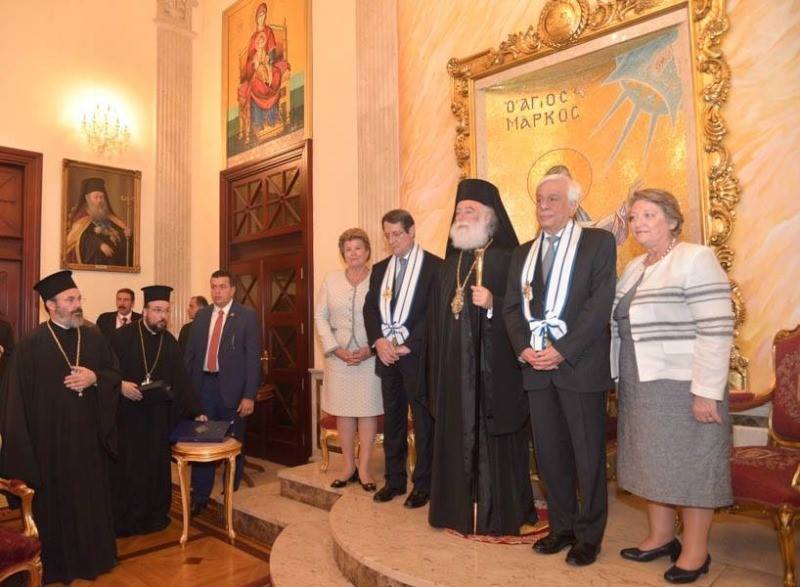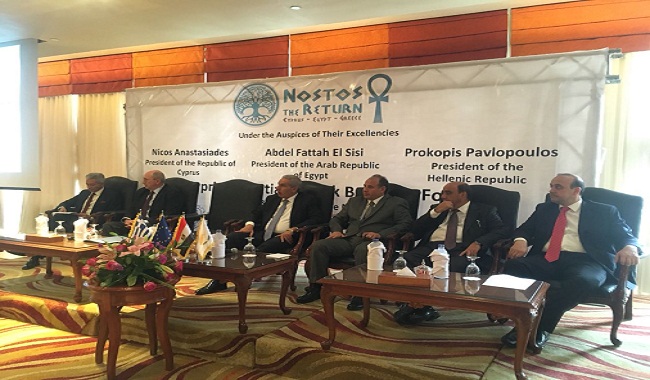 Nostos: Reviving roots
Nostos: Reviving roots
They called it Nostos. The encyclopaedia says ‘Nostos’ is Greek for the theme of a hero returning home from an epic journey—such as that of Homer’s legendary Odyssey. Today the term is used to denote a homecoming after long estrangement.
So it was perfectly fit that ‘Nostos’ should be used as the theme title for a week-long visit to Alexandria by Greeks and Cypriots who once lived there. To bring the name closer to Egyptian ears, the event was named: “Nostos: Reviving Roots”.



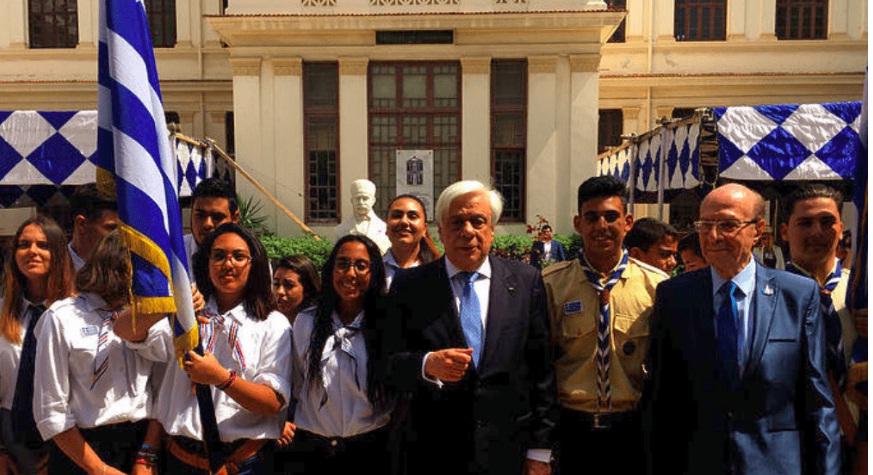
It was a top ranking initiative in which the presidents of Egypt, Greece, and Cyprus participated, upon invitation by President Abdel-Fattah al-Sisi and under the auspices of Egypt’s Ministry of Emigration and Egyptian Expatriate Affairs. The Minister, Nabila Makram, herself born and raised in Alexandria, chose with her Greek and Cypriot counterparts the name of the event.
Colourful, diverse
Alexandria, Egypt’s Mediterranean port city which is second only to Cairo in size, economic activity, and cultural significance, has always had a lively Greek element to it. The city was founded by Alexander the Great in the fourth BC century, and was Egypt’s capital throughout the ten-century period when Egypt was ruled by the Greeks from 330BC to 33BC then by the Romans from 33BC to 640AD when the Arabs conquered Egypt. The city was a major Mediterranean port; it was home to the famed Library of Alexandria and the Alexandria School; and was the seat of the Coptic Pope of Alexandria, Patriarch of the See of St Mark.
As the capital moved to Cairo in the 7th century, Alexandria gradually moved to second place, even though it retained significant military, economic, and cultural weight.
In modern times, waves of immigration from the north to the south of the Mediterranean started at the end of the 19th century. Back then, Greece and Cyprus were part of the Ottoman Empire. Egypt too was part of the empire, but under the rule of the Muhammad Ali Dynasty it enjoyed some form of autonomy and a thriving economy that attracted immigrants.
Alexandria became the most active of all the Greek communities around the Mediterranean. The Greeks integrated in the societies they lived in; many chose to stay on in Egypt, working, living and dying there. They had their houses, schools, shops and businesses big and small, churches and cemeteries. By the early decades of the 20th century there were over half a million Greeks and Cypriots living in Egypt, a large portion of them in Alexandria. They were well-loved and well-respected by mainstream Egyptians.
“The imprint of the Greeks and Cypriots on Alexandria cannot be overlooked,” Ms Makram says, “and has richly contributed to its colourful, diverse profile.”





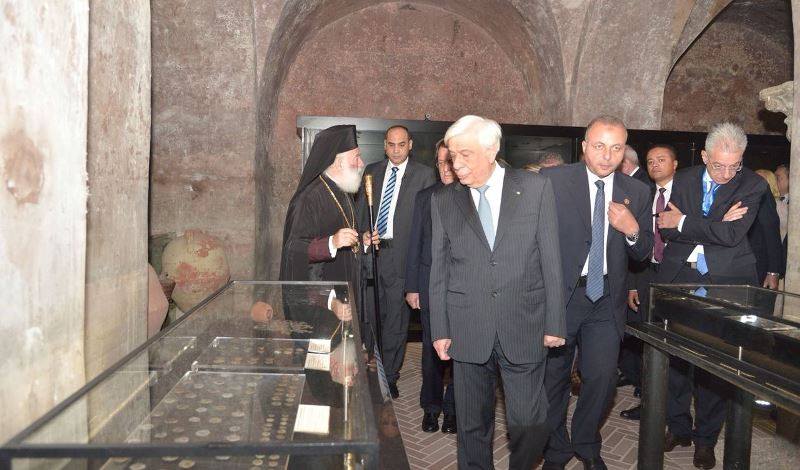
Summit
As political conditions in Egypt changed in the 1950s and 60s, many foreigners left, including Greeks and Cypriots. Today, Greeks number some 5,000 in Egypt, and Cypriots 500. Yet Greek ambassador to Egypt, Michael Diamesis, agrees with Cypriot ambassador Charis Mortisis that Greek presence is still strong in Alexandria, and is not merely relegated to monuments, churches and restaurants. The Greek and Cypriot communities, with their leaders and institutions, are still very active in Egypt.
For the hundreds of thousands who left, however, what has become of their homes and old haunts? This is where Nostos comes in.
Monday 30 April saw President Nicos Anastasiades of Cyprus, and President Prokopis Pavlopoulos of Greece join Egypt’s President Abdel-Fattah al-Sisi in inaugurating “Nostos: Reviving Roots” in Alexandria.
The event started with a summit of the three presidents at the marine base in Ras al-Tin. This was not the first; Egyptian, Cypriot and Greek ties have steadily gained in strength since President Sisi assumed office in 2014. The last four years already witnessed five summits, and the three countries are closely cooperating on regional and international issues. Their most recent summit at the outset of Nostos was attended by State Minister of Emigration, Nabila Makram; Greek, Cypriot and Egyptian officials and politicians; as well as Coptic Orthodox Pope Tawadros and Greek Orthodox Patriarch Theodoros II of Alexandria and All Africa. Discussions centred on enhancing cooperation in areas of interest of all three countries: energy, economy, naval transport, tourism, and culture. Security in the Mediterranean and battling terrorism, illegal immigration and racism were also discussed. It was decided to resolve any bureaucratic hurdles that may hinder full exploitation of the extensive energy resources in Egypt and Cyprus.
Building bridges
The Nostos activities included an Egyptian Greek Cypriot business forum that was held in Alexandria and attended by Alexandria Governor Muhammad Sultan and Minister of Trade and Industry Tarek Kabil. The forum was organised by the Egyptian union of chambers of commerce and saw participation of a large number of businessmen from the three countries. It culminated by signing a number of protocols.
Mr Kabil commended the economic ties between the three countries, pointing out that Egypt’s exports to Cyprus and Greece had seen a leap last year as a result of the rise in exports to the European Union. Egyptian exports included, among others: iron and steel, furniture, plastics, food industry products, fertilisers, oils, tableware, potatoes, frozen vegetables, and pumps. He said that Greek investment in Egypt reached some USD155 million in 160 projects in the fields of industry, tourism, services, construction, communications, finance, and agriculture.
A twinning agreement was signed between Alexandria and the Cypriot city of Paphos. Governor Sultan and Paphos mayor Fedonas Fedonos both praised the agreement, explaining that it was not simply about better business, tourism, sports, or social relations between the two cities, but was about building bridges between people and reviving age-old bonds between them.





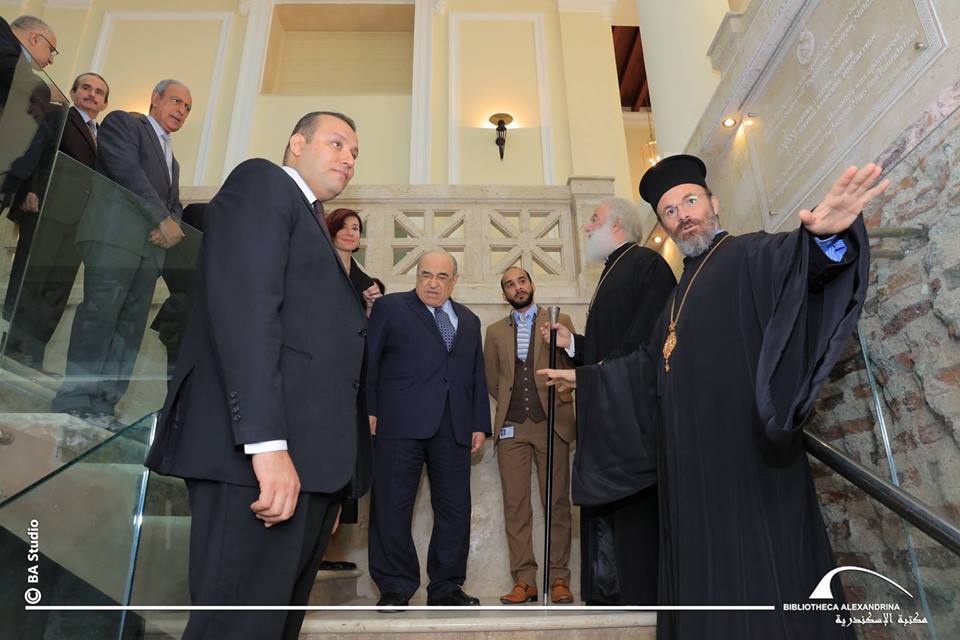
The Bibliotheca, and Greek Orthodox patriarchate
For Greek President Prokopis Pavlopoulos and his wife, as well as for some 140 Greeks and Cypriots, a highlight of Nostos was a visit to the Bibliotheca Alexandrina (BA). The BA is the modern-day version of the famed Library of Alexandria that was built in the 4th century BC and continued as a centre of enlightenment and learning till almost the 7th AD century. The BA, which was established in 2002, is working to attain the same goal of being a beacon of knowledge and thought, and is exploiting modern state-of-the-art technology to achieve that end. [http://en.wataninet.com/culture/heritage/rising-from-the-ashes-2/21588/]
President Pavlopoulos commended the enlightened thought and intercultural dialogue which the BA promotes, saying that dialogue between cultures is vital and serves to foster integration and understanding among people.
The tourists browsed through the galleries and museums, taking selfies and listening to the guides.
Another Nostos highlight was a warm hearted visit to Patriarch Theodoros II at the patriarchate in Alexandria. Patriarch Theodoros honoured the Greek and the Cypriot presidents with the Grand Cross of the Order of St Mark medal, for what he said was their continuous support to the Church. They, in turn, thanked him for the invaluable services the Church offers in Alexandria and Africa. The presidents were proudly shown the ancient Greek manuscript collection at the patriarchate, which was recently restored by the BA.






Reminiscence
A visit to the Greek Quarter in the central district of Shatby wrapped the Alexandria event. The Greek Quarter includes, among others: the Greek Consulate in Alexandria, which was built in 1972; the headquarters of the Greek Society in Alexandria; Greek schools; and a club; as well as the Greek Orthodox patriarchate which is housed in a building that had once been a Greek school. The visitors then moved on to the Greek cemetery in Shatby where many paid respects to relatives buried there.
Moving around in the Quarter, which was built in 1902, and the cemetery brought on many memories. There was talk about Constantinos Salvagos who was a major player in world trade and local business, one of the founders of the National Bank of Egypt, and an important personality in the cosmopolitan community of Alexandria, but whose sudden premature death in 1901 put an end to his career. Other Alexandria Greek prominent characters included Poet Constantine Cavafy (1863 – 1933) who gained Egyptian, Greek and international fame; John Antoniadis (1818 – 1895) who built in Alexandria the famous palace and gardens that bear his name, and which are today open to the public; George Averoff (1815 – 1899), a great businessman and philanthropist; and the Tositsa family who in 1830 arranged to build the Greek Hospital in Alexandria on private land owned by Michael Tositsa. The hospital is now State-owned and bears the name Gamal Abdel-Nasser Hospital.
Apart from the official itinerary, many Nostos participants went on to visit their old homes, friends, schools, and haunts. No matter how much the city had expanded and changed over the years, the scent of the old days lingered on.
The Nostos activities ended in Alexandria then moved to Cairo for a visit to the Pyramids and Cairo landmarks, and on to South Sinai’s Red Sea resort of Sharm al-Sheikh and the Greek Orthodox St Catherine’s Monastery in Mount Sinai.









____________________________
http://en.wataninet.com/culture/heritage/greeks-and-cypriots-visit-alexandria-in-a-return-to-their-roots/24022/

